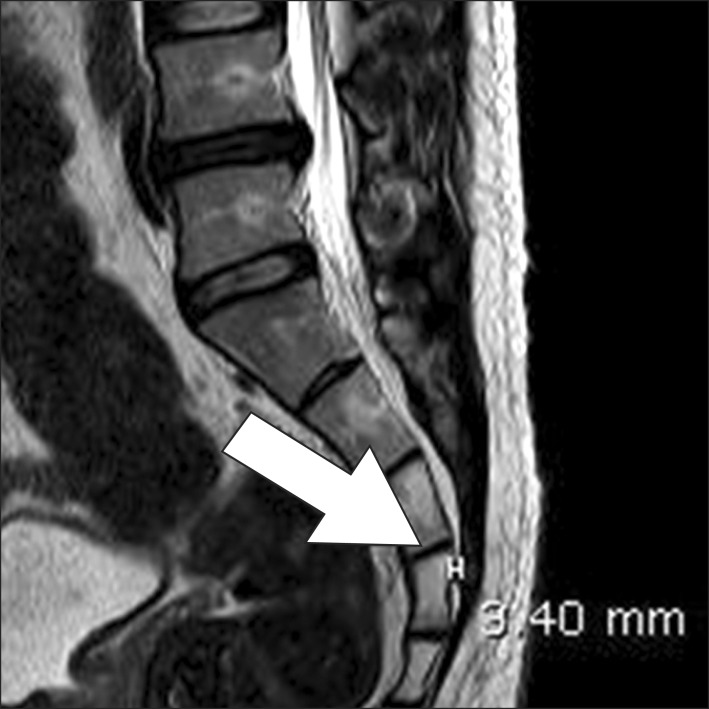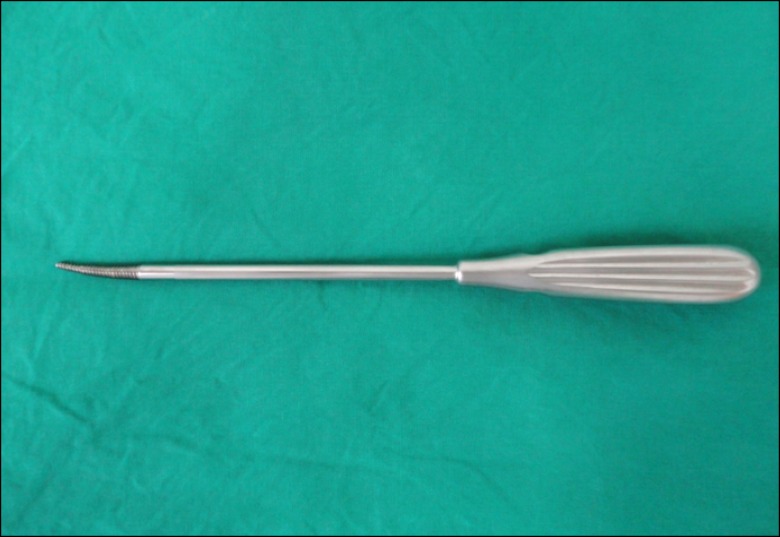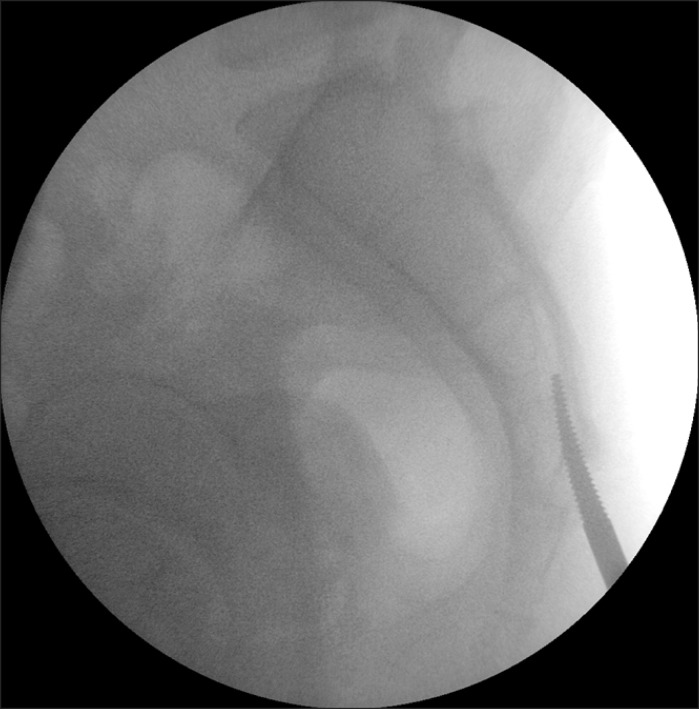Abstract
Epiduroscopy is very useful in the treatment of not only low back pain caused by failed back surgery syndrome, epidural scar or herniated disc but also by chronic refractory low back pain which does not respond to interventional conservative treatment including fluoroscopically-directed epidural steroid injections and percutaneous adhesiolysis. Because cauterization using a laser fiber has become recently available, a wider opening is required to enter into the sacral canal in the case of epiduroscopic laser neural decompression (ELND). However, in a few patients, it is difficult to insert a device into the epidural space due to stenosis around the opening, and there is no alternative method. Herein, we report a case where a hiatus rasp specially designed for such patients was used to perform the operation.
Go to : 
Use of an epiduroscope has been widely introduced in the treatment of chronic refractory low back pain which does not respond to interventional conservative treatment. The procedure using an epiduroscope has gradually been generalized because it has drawn attention as a tool for diagnosing chronic low back pain [1,2].
In epiduroscopic laser neural decompression (ELND), the outer diameters of both the video guided catheter and the introducer sheath have increased because a two-working channel system has been introduced for cauterization using a laser fiber. Hence, for the introducer sheath and the video guided catheter to access the anterior and posterior epidural spaces through the sacral hiatus, a wider hiatal opening is necessary. However, in a few patients, it is difficult to access the epidural space with the Seldinger technique because the sacral hiatus and the adjacent sacral canal, corresponding to the hiatal opening, are narrower than the outer diameter of the devices mentioned above. In these cases, the procedure has to be stopped, and the usefulness of the procedure may decrease because there is no other method to access the epidural space through the sacral hiatus [3]. Herein, we report a case where the space was made wider with an operative rasp and the procedure was continued in patients whose canal around the hiatal opening was narrow among patients who had undergone ELND at our institution.
A 32-year old male patient visited our institution with the chief complaint of pain in the right hip and the lower back which started after he had experienced a minor traffic accident ten months prior to his visit. The pain became severe when he bent his waist, and an paresthesia was found with a numbness going to the tip of the right middle toe. The physical examination showed a positive finding in the straight leg raising test (20 degree/60 degree). The lumbosacral plain film showed that the disc space between L4 and L5 was narrow. The patient had no particular history. The patient's pain was not relieved but continued even after a caudal epidural steroid injection as well as after interlaminar epidural steroid injections given at one week intervals. Because the magnetic resonance imaging (MRI) showed a central herniated lumbar disc between L4 and L5 and compression of the right L5 nerve root, we decided to perform ELND.
The patient was hospitalized one day before the operation, and provided written informed consent. He started fasting eight hours before the operation and showed nothing unusual in the preoperative blood test. On the day of the operation, cefazolin 1 g was intravenously injected one hour before the beginning of the operation for the purpose of preventing an operation related infection. The patient was put into the prone position on the surgical table after arriving at the operating room. The position was adjusted with a Wilson frame and a pillow at the abdomen so that lumbar flexion could be unfolded and the upper body could be a little bit higher than the lower body. Afterwards, a wide area around the sacral hiatus was disinfected with aseptic technique. Local anesthesia was performed in the region to be operated on with 1% mepivacaine. Under direct fluoroscopy guidance, an 18 G Tuohy epidural needle was inserted into the sacral hiatus through the epidural space, and a 0.8 mm guide wire was inserted through the Tuohy needle. Keeping the guide wire in position, the Tuohy needle was carefully removed. In the process of making a small incision on the skin with a No. 11 blade and inserting a dilator through the guide wire, an unexpected resistance was found with the access. Despite repeated attempts carried out several times, the insertion to the sacral canal failed. We stopped the operation temporarily and reviewed the lumbosacral MRI sagittal plane image. It was found in the image that the conjugate diameter of the top 1/3 of the S4 spinal canal was 3.40 mm, which was smaller than the 3.96 mm outer diameter of the dilator for the epiduroscopy introducer set used in the operation (4007 Epiduroscopy introducer set, Myelotec, USA), and smaller than the 3.89 mm outer diameter of the introducer sheath (Fig. 1). Therefore, we decided to perform a S4 laminotomy at the entrance of the narrowed sacral canal with a hiatus rasp (Fig. 2) designed to widen the canal opening. After making an incision of about 2 cm on the skin and on the sacrococcygeal ligament, the rasp was inserted into the narrowed region expanding the narrow sacral canal space by applying repeated rotational force (Fig. 3). Then, the dilator was normally inserted, and the channel and the space leading to the epidural space were widened, and the procedure could be stably completed. The patient's symptoms improved, and he was discharged two days after the operation.
Go to : 
ELND has been recently introduced and is drawing attention as a new method for diagnosis and treating not only herniated disc, spinal stenosis, and failed back surgery syndrome but also chronic refractory low back pain which is not treated well by other interventional treatments including C-arm guided epidural steroid injection [1,2]. In particular, Jo and Yang [1] asserted that epiduroscopy may be useful in investigating the causes of low back pain because it is applied to not only the treatment of chronic refractory low back pain but also to the diagnosis of low back pain, and predicted that the application of epiduroscopy would increase.
The outer diameter of the video guided catheter (Myelotec, USA) was increased to 3.0 mm because the system came with two working channels for the manipulation of the fiberoptic endoscope and the laser fiber. In addition, the outer diameter of the dilator inserting the catheter into the sacral canal and that of the introducer sheath were increased to 3.96 mm and 3.89 mm, respectively. This indicates that an epidural space even greater than the outer diameter of the 15 G RX coude needle (1.83 mm) for the conventional Racz catheter procedure and that of the introducer sheath of the Navi catheter (2.31 mm) is required. For this reason, an anatomical variation at the sacral canal opening including stenosis may often make access of a device needed for the procedure impossible, thus causing the failure of the procedure, bringing about a loss in time, effort and cost for the patient and medical staff, and even decreasing the usefulness of the procedure. Helm et al. [3] reported two such cases. In one case, when the Seldinger technique was performed at the sacral hiatus region to perform epiduroscopic adhesiolysis, a 0.9 mm guide wire was inserted but the 2.0 mm diameter dilator was not inserted. A vertical incision was made at the sacral hiatus, and hyperplastic cartilaginous tissue was found after dissecting the tissue until the hiatus was exposed, and the procedure was continued after removing it with a Kerrison rongeur. In the other case, the insertion of the epiduroscope failed one time. In the second attempt, the tissue surrounding the sacral hiatus was removed by blunt dissection, and the opening was widened, and then, the procedure was continued.
In anatomical studies on the sacrum with cadavers, Senoglu et al. [4] reported that the mean conjugate diameter of the sacral hiatus measured at the apex level was 4.5 mm (1.0 to 7.0 mm); Aggarwal et al. [5] reported that it was 4.0 mm (1.1 to 9.3 mm); and Sekiguchi et al. [6] reported that it was 6.0 mm (1.9 to 11.4 mm). They stated that the ratio of a diameter smaller than 2.0 mm was 6.25%, 6.1%, and 1%, respectively [4-6]. In a study where the sacrum and the caudal space were observed by MRI in 37 adult patients, Crighton et al. [7] reported that the mean canal conjugate diameter at the hiatal apex level was 4.6 mm (1.0 to 8.0 mm), and that only one patient showed a diameter smaller than 2.0 mm. Senoglu et al. [4] reported that the ratio of the sacral hiatal agenesis was 6.25%. Sekiguchi et al. [6] reported that the hiatal agenesis was 4%, bony septum 2%, and complete agenesis 1% at the sacral hiatus. These reports suggest that variations in the sacral canal opening region may cause difficulties, although rare, not only in epiduroscopy but also in all interventional procedures using a caudal approach. Therefore, it cannot be overemphasized that preoperative evaluation through various imaging techniques, including ultrasonography, computed tomography, and MRI, is important [8], and that the medical staff should be prepared in advance for patients who are expected to have difficulty in the procedure based on the preoperative evaluation results.
The above mentioned case reported by Helm et al. [3] and the anatomical studies of the sacrum [4-8] were not conducted by keeping the ELND in view because they were conducted before the introduction of ELND. Nevertheless, pain physicians should pay more attention when performing ELND because the devices for ELND currently have the greatest outer diameter among interventional procedures through the caudal opening at the sacral hiatus level. In addition, it is important to acquire knowledge on rare anatomical variations at the sacrococcygeal region, perform an evaluation in advance, and learn a method to cope with the variation for stable access to the epidural space for ELND.
The rasp used in this case report was designed as a cone with a helical surface. The total height of the cone was 32.0 mm; the diameter of the cone base was 6.0 mm, and the diameter of the cone at 1/2 the level of the cone height, which was 16.0 mm away from the cone vertex, was 4.0 mm. There has been no study or report until now regarding stenosis for what sacral level could be resolved or safely operated on without any possibility of nerve damage by using this device in the case where there is stenosis at the sacral hiatus opening region as in our case. However, we assume that the possibility of damage to the surrounding tissue and nerves could be minimized by considering the results of the sacrum anatomical studies mentioned above [4-8], by locating the rasp at the center of the sacral hiatus as much as possible under the C-arm guide, and by expanding the space by gradually moving to the fore while observing pain or other dysaesthesia through conversation with the conscious patient. We also expect that relevant studies will be actively conducted as ELND becomes more popular.
In this case report, a specially designed operative rasp was used to expand the canal space and to continue the ELND procedure in a patient whose canal around the hiatal opening was narrow at our institution. Meticulous care and caution by pain physicians are required while performing the procedure described in this case report.
Go to : 
References
1. Jo DH, Yang HJ. The survey of the patient received the epiduroscopic laser neural decompression. Korean J Pain. 2013; 26:27–31. PMID: 23342204.

2. Richter EO, Abramova MV, Cantu F, De Andres J, Lierz P, Manchiaro PL, et al. Anterior epiduroscopic neural decompression: eight-center experience in 154 patients. Eur J Pain Suppl. 2011; 5:401–407.

3. Helm S 2nd, Gross JD, Varley KG. Mini-surgical approach for spinal endoscopy in the presence of stenosis of the sacral hiatus. Pain Physician. 2004; 7:323–325. PMID: 16858469.
4. Senoglu N, Senoglu M, Oksuz H, Gumusalan Y, Yuksel KZ, Zencirci B, et al. Landmarks of the sacral hiatus for caudal epidural block: an anatomical study. Br J Anaesth. 2005; 95:692–695. PMID: 16155035.

5. Aggarwal A, Kaur H, Batra YK, Aggarwal AK, Rajeev S, Sahni D. Anatomic consideration of caudal epidural space: a cadaver study. Clin Anat. 2009; 22:730–737. PMID: 19637298.

6. Sekiguchi M, Yabuki S, Satoh K, Kikuchi S. An anatomic study of the sacral hiatus: a basis for successful caudal epidural block. Clin J Pain. 2004; 20:51–54. PMID: 14668657.

7. Crighton IM, Barry BP, Hobbs GJ. A study of the anatomy of the caudal space using magnetic resonance imaging. Br J Anaesth. 1997; 78:391–395. PMID: 9135359.

8. Macchi V, Porzionato A, Morra A, Stecco C, De Caro R. Radiologic anatomy of the sacral canal. Acta Neurochir Suppl. 2011; 108:5–8. PMID: 21107931.

Go to : 




 PDF
PDF Citation
Citation Print
Print





 XML Download
XML Download